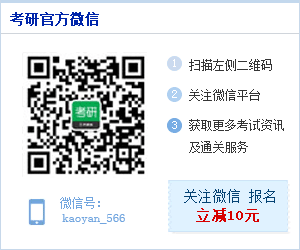[答案]2012年1月考研政治答案
Section I Use of English
Directions:
Read the following text. Choose the best word(s) for each numbered blank and mark A, B, C or D on ANSWER SHEET 1. (10 points)
Read the following text. Choose the best word(s) for each numbered blank and mark A, B, C or D on ANSWER SHEET 1. (10 points)
The ethical judgments of the Supreme Court justices have become an important issue recently. The court cannot _1_ its legitimacy as guardian of the rule of law _2_ justices behave like politicians. Yet, in several instances, justices acted in ways that _3_ the court’s reputation for being independent and impartial.
Justice Antonin Scalia, for example, appeared at political events. That kind of activity makes it less likely that the court’s decisions will be _4_ as impartial judgments. Part of the problem is that the justices are not _5_by an ethics code. At the very least, the court should make itself _6_to the code of conduct that _7_to the rest of the federal judiciary.
This and other similar cases _8_the question of whether there is still a _9_between the court and politics.
The framers of the Constitution envisioned law _10_having authority apart from politics. They gave justices permanent positions _11_they would be free to _12_ those in power and have no need to _13_ political support. Our legal system was designed to set law apart from politics precisely because they are so closely _14_.
Constitutional law is political because it results from choices rooted in fundamental social _15_ like liberty and property. When the court deals with social policy decisions, the law it _16_ is inescapably political-which is why decisions split along ideological lines are so easily _17_ as unjust.
The justices must _18_ doubts about the court’s legitimacy by making themselves _19_ to the code of conduct. That would make rulings more likely to be seen as separate from politics and, _20_, convincing as law.
1. [A]emphasize [B]maintain [C]modify [D] recognize
2. [A]when [B]lest [C]before [D] unless
3. [A]restored [B]weakened [C]established [D] eliminated
4. [A]challenged [B]compromised [C]suspected [D] accepted
5. [A]advanced [B]caught [C]bound [D]founded
6. [A]resistant [B]subject [C]immune [D]prone
7. [A]resorts [B]sticks [C]loads [D]applies
8. [A]evade [B]raise [C]deny [D]settle
9. [A]line [B]barrier [C]similarity [D]conflict
10. [A]by [B]as [C]though [D]towards
11. [A]so [B]since [C]provided [D]though
12. [A]serve [B]satisfy [C]upset [D]replace
13. [A]confirm [B]express [C]cultivate [D]offer
14. [A]guarded [B]followed [C]studied [D]tied
15. [A]concepts [B]theories [C]divisions [D]conceptions
16. [A]excludes [B]questions [C]shapes [D]controls
17. [A]dismissed [B]released [C]ranked [D]distorted
18. [A]suppress [B]exploit [C]address [D]ignore
19. [A]accessible [B]amiable [C]agreeable [D]accountable
20. [A]by all mesns [B]atall costs [C]in a word [D]as a result
Section II Reading Comprehension
Part A
Directions:
Read the following four texts. Answer the questions below each text by choosing A, B, C or D. Mark your answers on ANSWER SHEET 1. (40 points)
Text 1
Come on –Everybody’s doing it. That whispered message, half invitation and half forcing, is what most of us think of when we hear the words peer pressure. It usually leads to no good-drinking, drugs and casual sex. But in her new book Join the Club, Tina Rosenberg contends that peer pressure can also be a positive force through what she calls the social cure, in which organizations and officials use the power of group dynamics to help individuals improve their lives and possibly the word.
Rosenberg, the recipient of a Pulitzer Prize, offers a host of example of the social cure in action: In South Carolina, a state-sponsored antismoking program called Rage Against the Haze sets out to make cigarettes uncool. In South Africa, an HIV-prevention initiative known as LoveLife recruits young people to promote safe sex among their peers.
The idea seems promising,and Rosenberg is a perceptive observer. Her critique of the lameness of many pubic-health campaigns is spot-on: they fail to mobilize peer pressure for healthy habits, and they demonstrate a seriously flawed understanding of psychology.” Dare to be different, please don’t smoke!” pleads one billboard campaign aimed at reducing smoking among teenagers-teenagers, who desire nothing more than fitting in. Rosenberg argues convincingly that public-health advocates ought to take a page from advertisers, so skilled at applying peer pressure.
But on the general effectiveness of the social cure, Rosenberg is less persuasive. Join the Club is filled with too much irrelevant detail and not enough exploration of the social and biological factors that make peer pressure so powerful. The most glaring flaw of the social cure as it’s presented here is that it doesn’t work very well for very long. Rage Against the Haze failed once state funding was cut. Evidence that the LoveLife program produces lasting changes is limited and mixed.
There’s no doubt that our peer groups exert enormous influence on our behavior. An emerging body of research shows that positive health habits-as well as negative ones-spread through networks of friends via social communication. This is a subtle form of peer pressure: we unconsciously imitate the behavior we see every day.
Far less certain, however, is how successfully experts and bureaucrats can select our peer groups and steer their activities in virtuous directions. It’s like the teacher who breaks up the troublemakers in the back row by pairing them with better-behaved classmates. The tactic never really works. And that’s the problem with a social cure engineered from the outside: in the real world, as in school, we insist on choosing our own friends.
21. According to the first paragraph, peer pressure often emerges as
[A] a supplement to the social cure
[B] a stimulus to group dynamics
[C] an obstacle to school progress
[D] a cause of undesirable behaviors
22. Rosenberg holds that public advocates should
[A] recruit professional advertisers
[B] learn from advertisers’ experience
[C] stay away from commercial advertisers
[D] recognize the limitations of advertisements
23. In the author’s view, Rosenberg’s book fails to
[A] adequately probe social and biological factors
[B] effectively evade the flaws of the social cure
[C] illustrate the functions of state funding
[D]produce a long-lasting social effect
24. Paragraph 5shows that our imitation of behaviors
[A] is harmful to our networks of friends
[B] will mislead behavioral studies
[C] occurs without our realizing it
[D] can produce negative health habits
25. The author suggests in the last paragraph that the effect of peer pressure is
[A] harmful
[B] desirable
[C] profound
[D] questionable
相关推荐:
·万题库:2021考研数学二在线估分已上线 点击下载 (2020-12-29)
·下载:2021年考研《数学一》真题及答案解析 (2020-12-29)
·下载:2021年考研《数学二》真题及答案解析 (2020-12-29)
·万题库版:2021年考研《数学二》真题及答案解析 (2020-12-28 2:17:46)
·万题库版:2021年考研《数学一》真题及答案解析 (2020-12-28 0:16:18)
·免费真题 ·模考试题


- 1
- 2
- 3
- 4
- 5
- 6
- 7
- 8
- 9
- 10
| · | 2022考研复试联系导师有哪些注意事 | 04-28 |
| · | 2022考研复试面试常见问题 | 04-28 |
| · | 2022年考研复试面试回答提问方法有 | 04-28 |
| · | 2022考研复试怎么缓解缓解焦虑心态 | 04-27 |
| · | 2022年考研复试的诀窍介绍 | 04-27 |
| · | 2022年考研复试英语如何准备 | 04-26 |
| · | 2022年考研复试英语口语常见句式 | 04-26 |
| · | 2022年考研复试的四个细节 | 04-26 |
| · | 2022考研复试准备:与导师及时交流 | 04-26 |
| · | 2022考研复试面试的综合技巧 | 04-26 |

实用文档 | 入党资料 | 入党申请书 | 入党志愿书 | 个人自传 | 转正申请书 | 思想汇报 | 个人简历 | 简历模板 | 简历封面 | 工作计划 | 工作总结 | 自我评测
个性评测 | 社交评测 | 事业评测 | 运势评测 | 报告 | 实习报告 | 工作总结 | 社会实践 | 心得体会 | 述职报告 | 调查报告 | 辞职报告
法律文书 | 合同范本 | 演讲范文 | 更多>>
英语学习 | 听力口语 | 阅读写作 | 翻译文化 | 趣味英语 | 学习方法 | 英文经典歌曲 | 每日课堂 | 空中英语 | 少儿英语 | 影视英语 | 英文歌曲 | 更多>>
作文大全 | 作文 | 小学 | 初中 | 高中 | 话题作文 | 考研 | 四六级 趣味作文 | 体裁作文 | 记叙文 | 议论文 说明文 | 应用文 | 读后感 | 作文素材 | 名言警句
优美段落 | 哲理故事 | 诗词赏析 | 成语知识 | 技巧 | 写作指导 | 作文点评 | 佳文赏析 | 写作基础 | 话题演练 | 作文教学 | 更多>>



